Thomas Harris & Son
Thomas Harris Sr., ca. 1757 - 1831
Thomas Harris Jr., 1780 - 1808
Thomas Phillips Harris, 1806 - 1892
William Harris, 1787 - 1843
William Dollond Harris, 1818 - 1861
Henry Harris, 1839 - 1928
by Brian Stevenson
last updated December, 2025
The London optical business of Thomas Harris and Son spanned the entire nineteenth century. The business produced creatively-designed microscopes during the early 1800s, but began centering on eyeglasses, telescopes, opera glasses, and globes by the 1830s. The earliest identified record of the business, from 1797, gave the firm’s name as “T. Harris”. Thomas’ eldest son had joined him by 1803, and the business was known as “T. Harris & Son” for the next hundred or so years, even as it was passed down through family members.
While researching the history of Thomas Harris & Son, it became evident that many modern historians had confused that business with others named Harris. Most notable are assumptions that T. Harris & Son was connected with William Harris of Holborn - this is false, there were no relationships between the two families. Thomas Harris had a son named William, but he never worked from Holborn. Several incorrect addresses for T. Harris and his descendants have been given by Gloria Clifton and others, evidently confusing our Harris family with other men having that relatively common name.
Some key dates:
1780: Later advertisements state that the business began in this year. It was 9 years after Thomas began his apprenticeship.
1797: First identified record of Thomas Harris being in business, at 30 Hyde Street. It is likely that he worked as a contractor for the trade between 1780 and 1793, thereby being “in business”, but not to the extent that he would be recorded in directories.
1803: Earliest identified record of “T. Harris & Son”. His eldest son, Thomas Jr., was then 22-23 years old, and would have completed apprenticeship training. Son William was only 15-16 years old, and so only a couple of years into his training (William became a globe-maker, so may have apprenticed with an outside craftsman). Thomas Sr. paid for admission into the Spectaclemakers' guild in 1804.
1808: Thomas Harris Jr. died while fighting a fire (he was an officer in the local volunteer fire department).
ca. 1810: Thomas Harris & Son moved to 52 Great Russell Street
ca. 1827: Thomas Harris Sr. and son William purchased the business at 22 Cornhill that had previously been owned by Thomas Blunt.
1828: Dissolution of the partnership between Thomas and William Harris. Thomas kept 52 Great Russell Street, as “T. Harris & Son”. William retained 22 Cornhill, evidently specializing in making globes.
1830: William Harris filed for bankruptcy protection, yet retained the business at 22 Cornhill.
1831: Thomas Harris Sr. died. He left his business to his grandson, Thomas Phillips Harris, the son of Thomas Jr.
1835: William Harris moved his business from 22 Cornhill to 63 King William Street.
1840: William Harris was imprisoned for debts, and declared bankruptcy. He was then a “coffee shopkeeper”. William died in 1843. His son, William Dollond Harris, continued an optical and globe-making business for several years, at 38 Arundel Street, then died in 1861.
1851: T. Harris & Son briefly opened a branch at 141 Oxford Street.
1887: Thomas Phillips Harris sold T. Harris & Son to his nephew, Henry Harris (son of Henry Evans Harris, who was the second son of Thomas Harris Jr.). The business coalesced with Henry Harris’ optical business at 32 Gracechurch Street, continuing as T. Harris & Son.
ca. 1901: T. Harris & Son ended. Henry Harris retired.
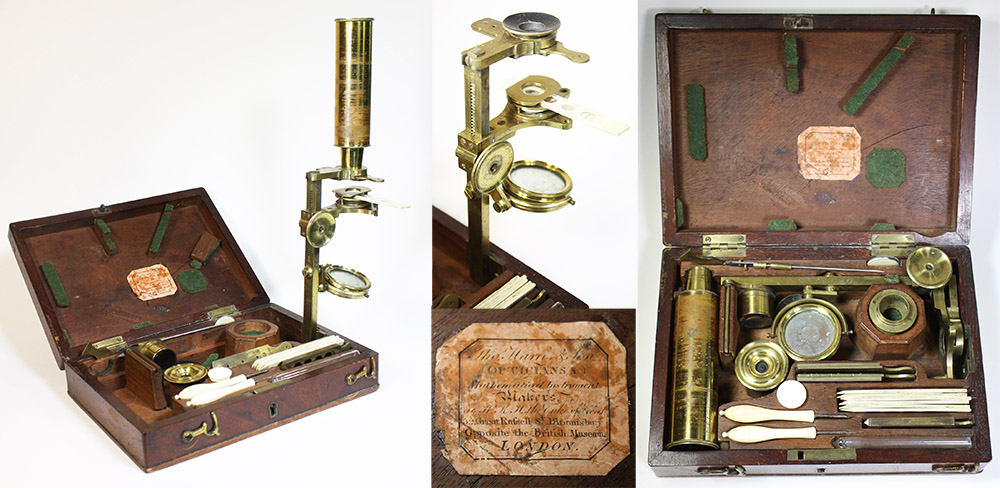
Figure 1.
Circa 1810 “Timothy Lane” portable microscope by T. Harris & Son. It can be used as either a compound or a simple microscope. The label gives the address of 52 Great Russell Street, to which the firm moved ca. 1810. Timothy Lane (1734-1807) was an English apothecary, scientist, and inventor. Lane evidently played a hand in the development of this unique form of portable microscope.
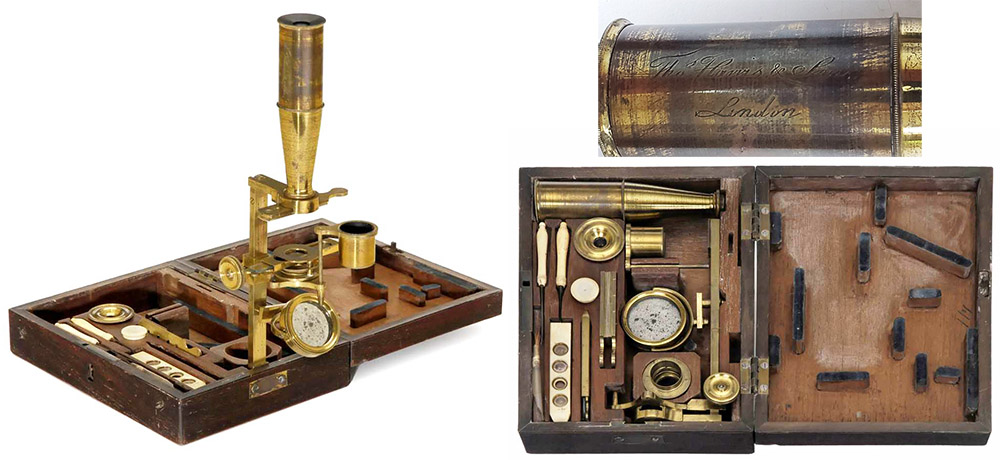
Figure 2.
A T. Harris & Son “Lane” microscope with a conical body tube. The compound body is engraved with Harris’ name. Adapted with permission from Jeffrey Silverman.
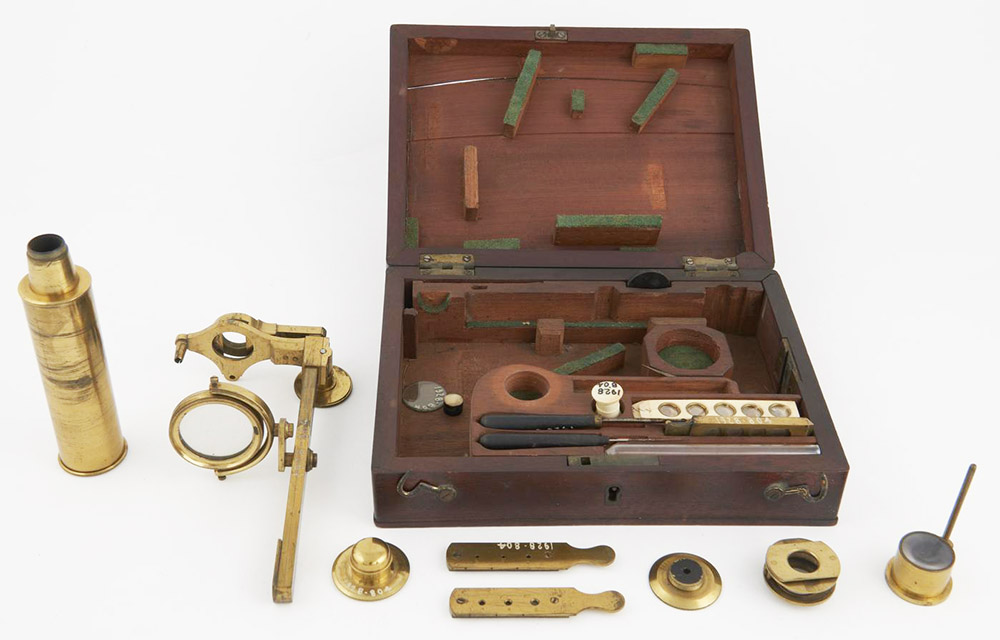
Figure 3A.
An exhibit of the UK Science Museum Group, described as “Timothy Lane’s Portable Microscope by Harris”. Adapted for nonprofit, educational purposes from https://collection.sciencemuseumgroup.org.uk/objects/co8445/timothy-lanes-portable-microscope-by-harris-with
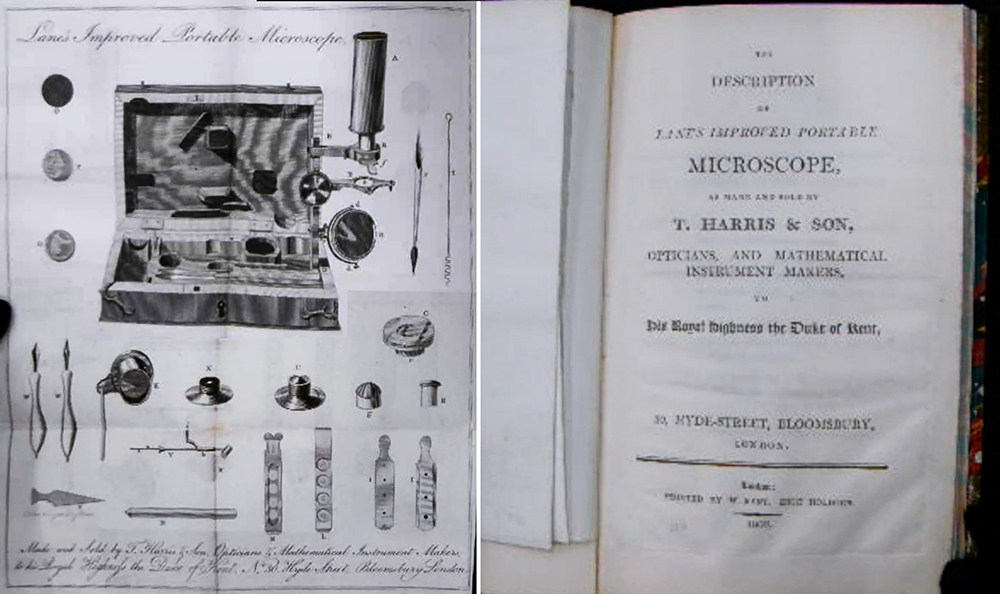
Figure 3B.
Images from an 1806 booklet that is in possession of the UK Science Museum Group, "The Description of Lane's Improved Portable Microscope, as Made and Sold by T. Harris and Son". Composite of sceenshots taken during an online meeting with Helen Rayner of the Science Museum Group National Collections Centre Collection Access Team.
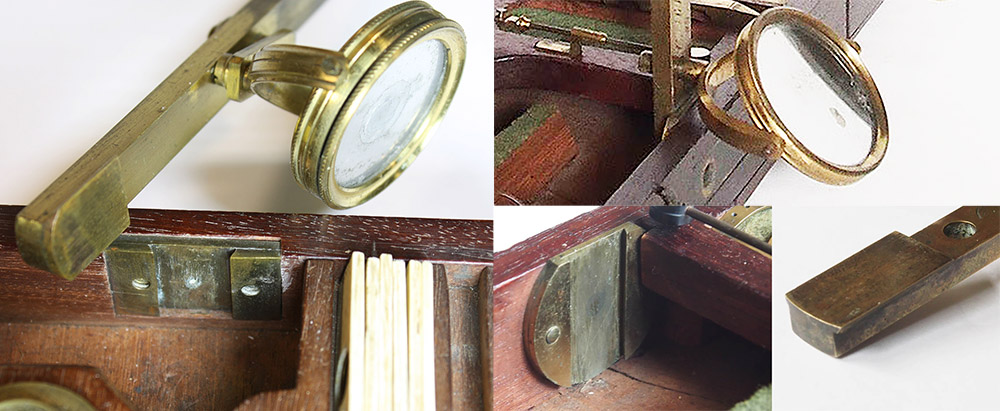
Figure 4.
Two features that discern Harris’ “Lane” portable microscope from those of another maker (who was probably Thomas Rubergall - see below). The dovetail fitting of the Harris-type is rectangular and mounted flush inside the case, while the Rubergall-type is circular/oval, and mounted so that it juts into the case. Also, the Harris-type mirror is mounted on an angular pivot (perhaps for oblique lighting?), while the Rubergall-type has a simple rod that fits into the upright. Other differences between microscopes attributable to Harris and those of the other maker include Harris’ inclusion of a large simple lens, a pair of sliding lens-holders that each contain 3 lenses, an octagonal mount inside the case for holding the Bonanni stage, and prominent placement of two dissecting tools (compare Figures 1-7). Differences between the Harris version and others may be the reason that Harris included the word “improved” in the published description of their microscope.
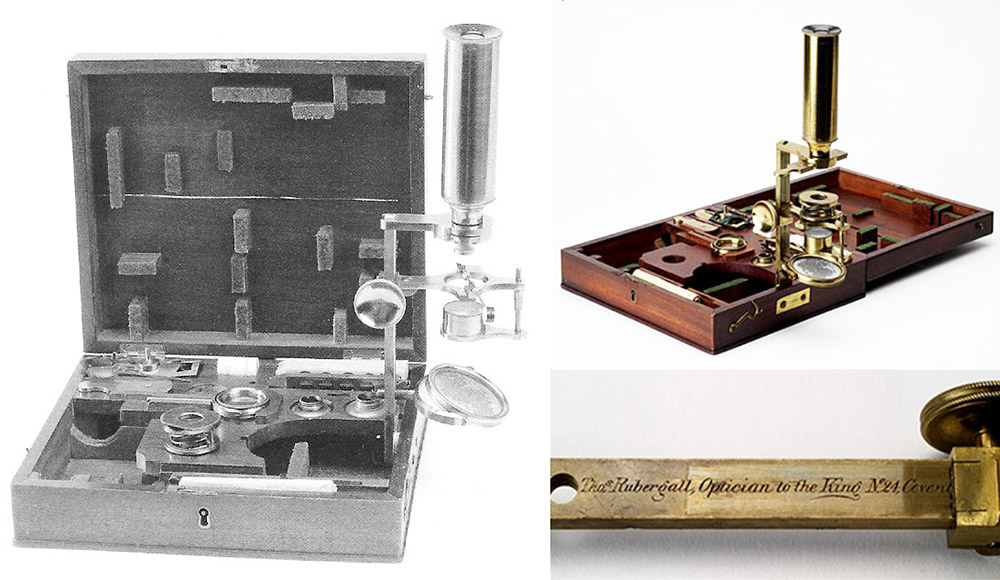
Figure 5.
A Lane pocket microscope, signed by Thomas Rubergall (1775-1854). Rubergall was an esteemed manufacturer of optical apparatus, and was probably the maker of this microscope. Differences between this and those of Thomas Harris & Son are described in Figure 4, above. Adapted for nonprofit, educational use from the Boerhaave Museum, Leiden, Netherlands.

Figure 6.
A Lane microscope, signed by Charles Schmalcalder (1781-1843), but essentially identical to the Rubergall-signed microscopes shown in Figure 5. Schmalcalder was a noted mechanical engineer, rather than a maker of optical apparatus. He probably acquired this microscope from a wholesale manufacturer (likely Rubergall). Adapted by permission of Jurriaan de Groot and https://www.microscope-antiques.com/schmal.html.
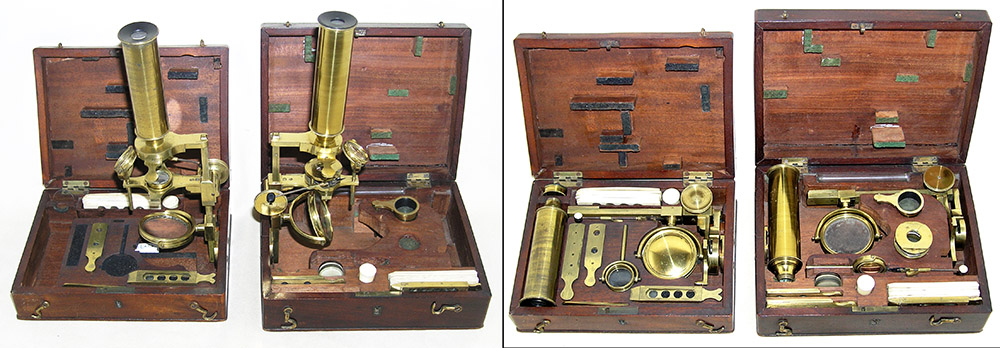
Figure 7.
Two unsigned Lane microscopes, but bearing features suggestive of construction by Thomas Rubergall. Components of these two microscopes are interchangeable with each other, indicating construction by the same person.

Figure 8.
Circa 1820-30 “Harris & Son's Portable Microscope”. Described as “arranged on an ingenious plan to secure portability. ... By unscrewing the tube, and screwing it into the lower side of the ring which holds it, and closing the tripod legs together, it is reduced. ... The subsidiary leg, which carries the mirror, folds against the leg of the tripod to which it is attached. The stage is removable, leaving a ring, which is attached by three supports to the tripod, and rises and falls somewhat as the tripod legs are shut or opened”. Images adapted for nonprofit, educational purposes from (left to right) Brian Bracegirdle’s “Science Museum, London”, https://collection.sciencemuseumgroup.org.uk/objects/co8206/portable-microscope-by-t-harris-and-son-in-case, and “The Journal of the Royal Microscopical Society”, 1884.
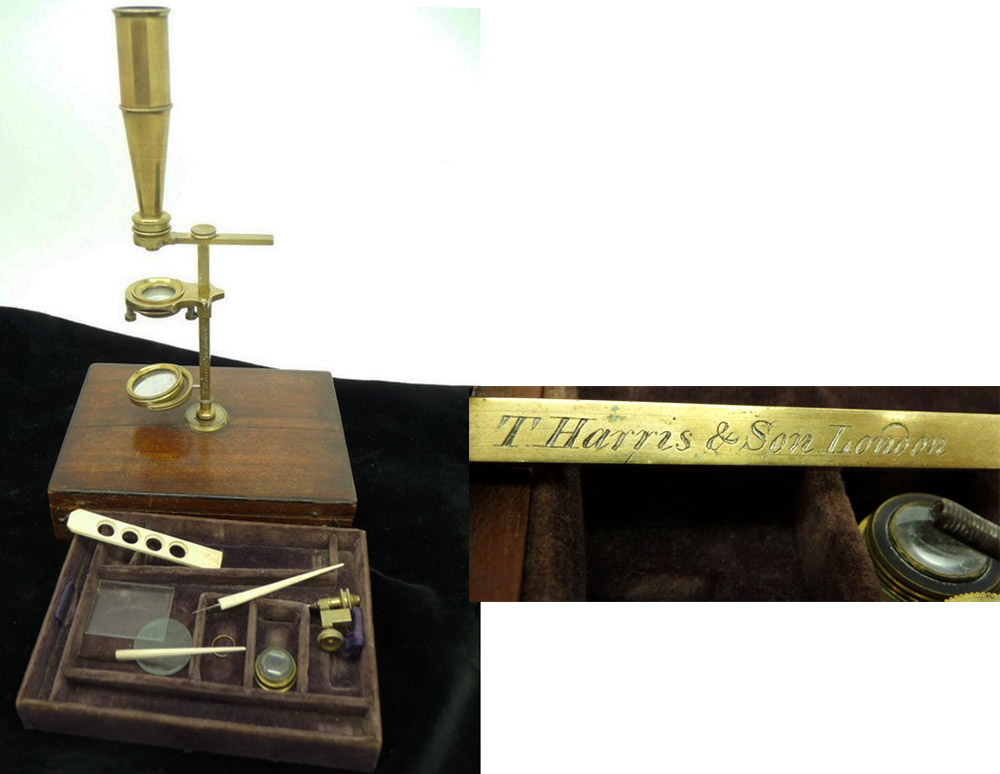
Figure 9.
A circa 1830 case-mounted “Gould-type” microscope, by T. Harris & Son. Adapted for nonprofit, educational purposes from an internet auction site.

Figure 10.
A Culpeper-type microscope, with a label in the case showing retail by T. Harris & Son. The label states that Harris & Son were “Optician and Mathematical Instrument Makers to His Royal Highness the Duke of Kent” - Prince Edward, the Duke of Kent, died in 1820, thus dating this microscope to before that year. Adapted for nonprofit, educational purposes from an internet retail site.

Figure 11.
Another Culpeper-type microscope by Harris & Son. A label on the microscope’s base gives the addresses of both Cornhill and Great Russell, thereby dating its production to 1827-1828. The label on the case has the Cornhill address blacked out, indicating sale after son William left the patnership in 1828. Adapted for nonprofit, educational purposes from https://collection.sciencemuseumgroup.org.uk/objects/co8135/microscope-by-thomas-harris-and-son-microscope.
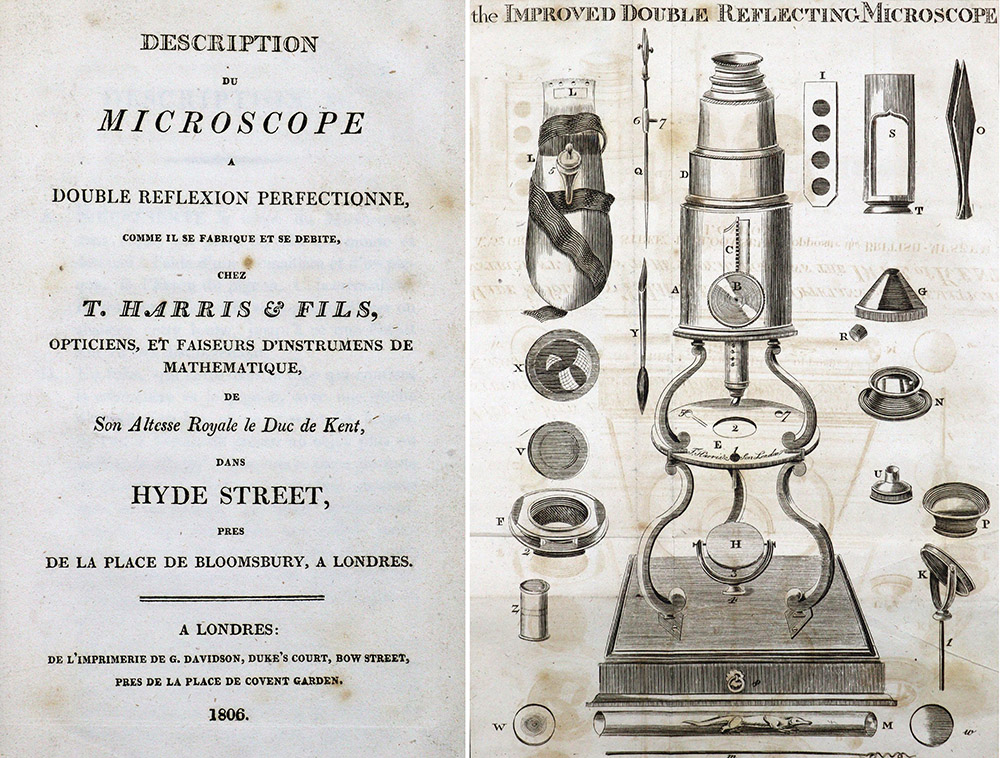
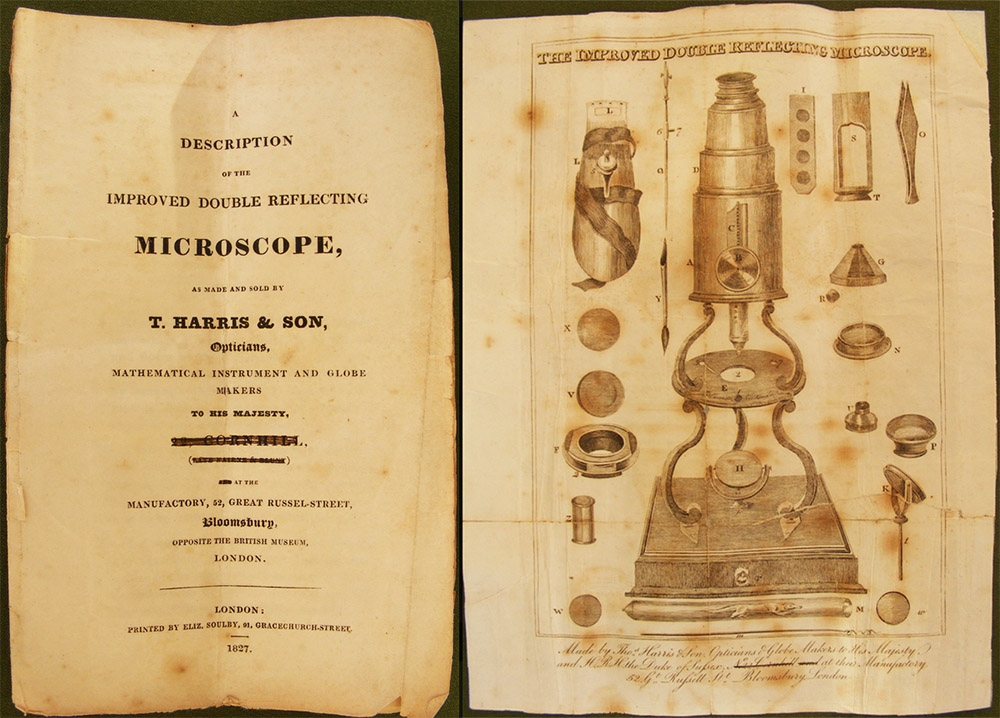
Figure 11B.
1806 (top) and 1827 (bottom) pamphlets that describe T. Harris & Son's "Culpeper-type" microscope. Note the addresses on each edition. The 22 Cornhill address on the 1827 edition was crossed out, implying that it was provided by Harris after the 1828 dissolution of business with son William. Adapted for nonprofit, educational purposes from internet sales sites.
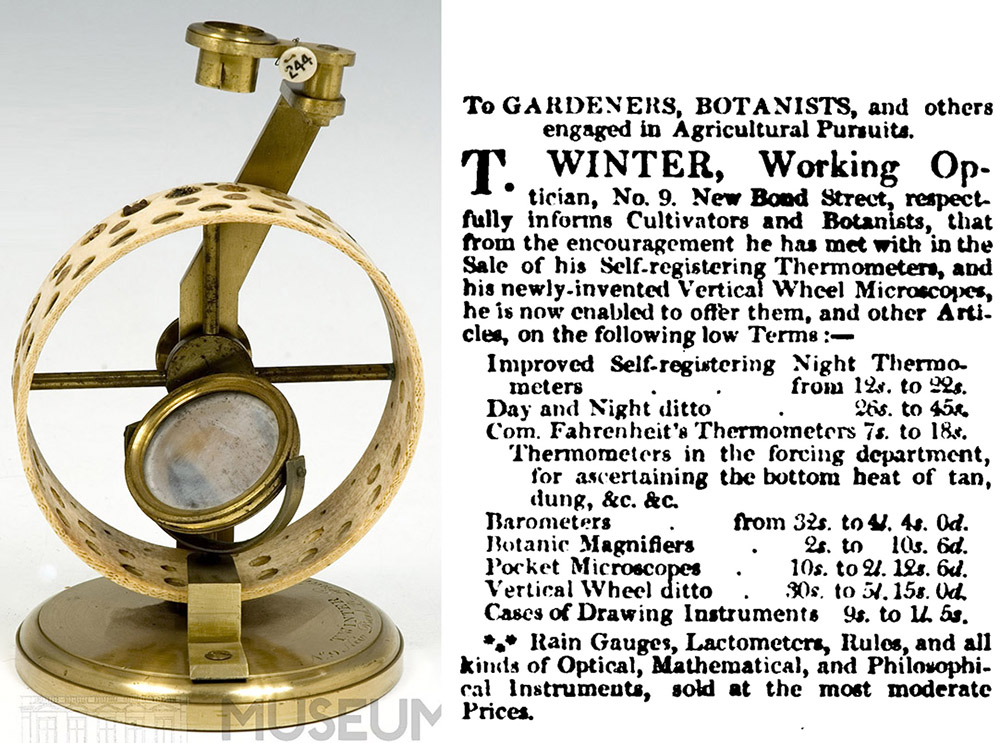
Figure 12.
Left: “vertical wheel” microscope, made by Thomas Winter, 9 New Bond Street, London. This model is known to have been retailed by T. Harris & Son. Right: An 1827 advertisement for this microscope by Winter - note that he described the vertical wheel microscope as "newly-invented". In 1884, Thomas Phillips Harris told the Royal Microscopical Society that “Thomas Winter was the ‘first and true inventor’ of these instruments … Winter worked for Mr. Harris, and sold the first model to him … Later Winter made some for Rubergall ... He also made some much smaller ones, which were sold for a few shillings”. Adapted for nonprofit educational purposes from the Oxford Museum of the History of Science.
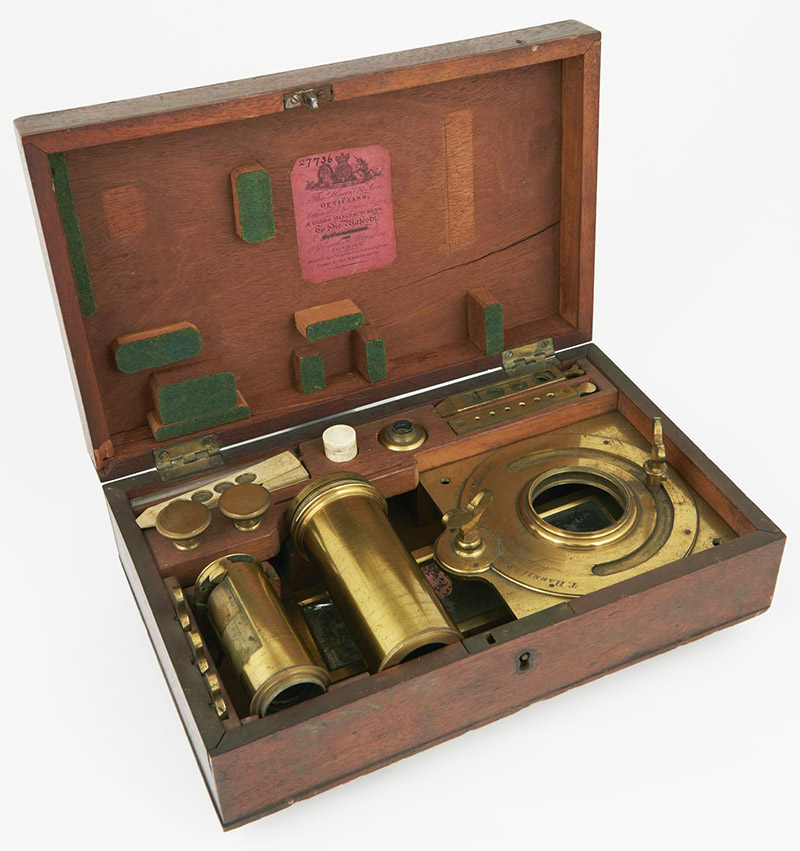
Figure 13.
A solar microscope from Thomas Harris & Son, 52 Great Russell Street. Adapted by permission of Maurizio Pizzigoni and https://collection.sciencemuseumgroup.org.uk/objects/co119035/solar-microscope-with-rack-barrel-objective-in-ma-solar-microscopes.
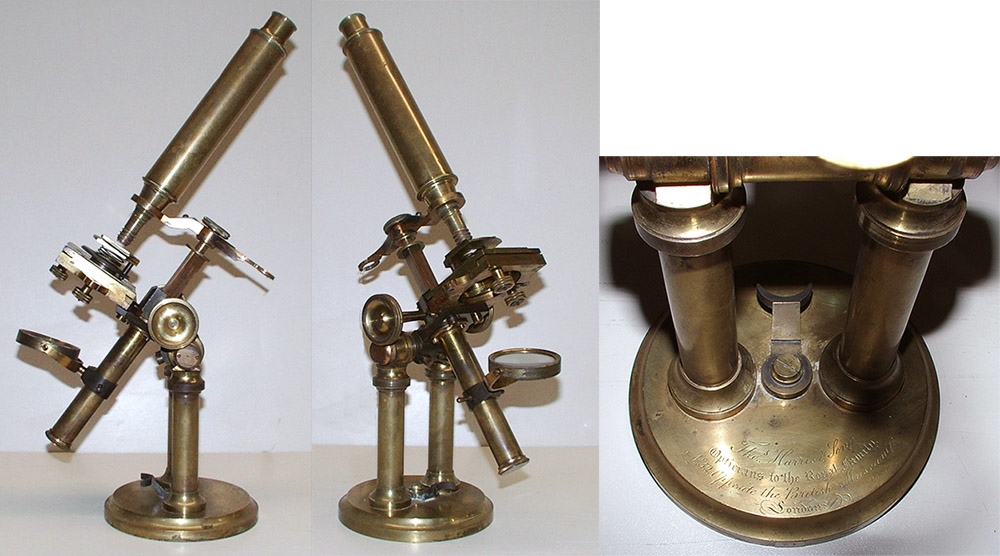
Figure 14.
A compound microscope, signed “Thos. Harris & Son, Opticians to the Royal Family, No. 52 Opposite the British Museum, London”. Adapted for nonprofit, educational purposes from http://www.oldmicroscopes.com/old-microscopes-Harris_Thomas_AND_Sons-29#.
The earliest known record of Thomas Harris is his 1771 apprenticeship contract with George Linnell, a “spectaclemaker” on Goldsmith Street, London (Figure 15). Boys were generally apprenticed at 13-14 years of age. Additionally, his July, 1831 burial record stated that Thomas was then 74 years old. These suggest a birth date of ca. 1857 for Thomas. His father, also named Thomas, was noted as being deceased in 1771, and had been a “tallow chandler” (i.e. wax candle-maker) in Newington Butts, Surrey.
Later advertisements stated that Thomas began an independent business in 1780. No records of such a business have been uncovered, so it is possible that Thomas worked as a contractor for other optical businesses.
The birth of his first child, Thomas Jr., on May 27, 1780, provides further evidence of financial independence at that time. This first child was baptized at St. Bride’s, Fleet Street Church. When the next child, Mary Ann, was baptized in 1784, the Harris family lived on Princes Street and she was baptized at St. Leonard’s, Shoreditch. The third known child, William, was born on April 6, 1787, and baptized at St. George’s, Bloomsbury. Thomas and his wife, Catherine, remained in the Bloomsbury area for the remainder of their lives. The next four known children were also baptized at St. George’s, Bloomsbury (Charles on September 7, 1788; Elizabeth on August 1, 1790; Ann on April 15, 1792; and Samuel on November 3, 1793).
The first known evidence of Thomas Harris’ business is an advertisement from 1797 (Figure 16). Thomas stated that he had invented a new form of geometric compass. Perhaps he thought that this breakthrough was sufficient for him to strike out as an independent businessman. The shop was located at 30 Hyde Street, Bloomsbury, London.
Although he was not yet a full member of a guild, Thomas Harris “Optician” of “Hyde St Bloomsbury” took one William Bassett as an apprentice in July, 1800.
The business had become “T. Harris & Son” by the time that the 1803 Kent’s Directory of London was printed (Figure 17). Thomas Jr. was the only son old enough to have partnered with his father.
Thomas Sr. was admitted to the Spectaclemakers’ guild on October 30, 1804. Thomas Jr. joined the Loriners’ guild on December 11, 1804.
In 1806, Harris published The Description of Lane's Improved Portable Microscope, as Made and Sold by T. Harris and Son (Figure 3). This described their version of a microscope that evidently was developed by Timothy Lane (1734-1807), an apothecary and scientist (Figures 1-3). At least one other manufacturer produced Lane-type microscopes at that time, so Harris’ use of the word “improved” may have been used to imply that theirs was the best.
Thomas Jr. married in about 1805. Their first child, Thomas Phillips Harris, was born on January 2, 1806. His baptism record gives the family’s address as 140 Fleet Street. Clifton states that this was a business address of Thomas Harris. I have not found any records of a shop at this site - it may have been a separate home of Thomas Jr. and his wife, Elizabeth, or it may have been a short-lived branch shop. The 1807 Post Office Directory of London lists only “30 Hyde-st” for the business.
Thomas Jr. and Elizabeth Harris had a second child on February 18, 1807, named Henry Evans Harris. This child’s son, also Henry, would eventually acquire the T. Harris & Son business from his uncle, Thomas Phillips Harris.
Thomas Harris Jr. was additionally a sergeant in his neighborhood firefighting organization, The Bloomsbury Volunteers. About four o'clock in the morning of September 20, 1808, fire was discovered at the Covent Garden Theatre. “Within less than three hours after its commencement, the whole of the interior of the theatre was destroyed: nearly the whole of the scenery, wardrobe, musical and dramatic libraries, and properties of all kinds, were a heap of smoking ruins. All the books and papers relative to the concerns of the theatre, as well as the produce of the preceding night's performance, were preserved. A considerable number of engines promptly attended, but there was a shameful want of water for some time. It was upwards of an hour before some of the engines could be supplied. They afterward played with the utmost possible effect for upwards of an hour, when the roof of the theatre fell in with a dreadful crash, and thus announced the destruction of the interior of this elegant building. The fire raged with most violence at the upper end of Bow street, the western side of which, nearly as far as the Police office, was soon burned down, to the extent of seven or eight houses, including the public house called the Strugglers. In Hartstreet the flames communicated to the houses on the opposite side of the street from the theatre, and four of them caught fire at the same moment; but by the great activity of the people and firemen, they suffered little more damage than a severe scorching. Great apprehensions were entertained for the safety of Drury-lane theatre, as the flakes of fire were carried on by the wind with force and in great quantities in that direction. A great number of people mounted the roof, ready in case of actual fire, to open the large cistern of water provided there. They also stuffed the windows with wet cloths, to prevent the entrance of the flames, and thus secured the theatre. All the people in the neighbourhood took a similar precaution, and were employed with their servants in picking up the flakes of fire as they fell upon the roofs or in the yards. This is the whole extent of injury sustained in the neighbourhood; but as to the theatre itself, it is totally consumed, and on the Hart-street side, not even the walls are standing. The Ship public house, two houses adjoining, and Mr. Brandon's, the Box-keeper's Office, are all that remain at that angle. The most painful part of this dreadful event remains to be described. At an early stage of the fire, a party of firemen broke open the great door under the Piazza, on the western side, and having introduced an engine into the passages in the interior, they directed it towards the galleries, where the fire appeared to burn most fiercely, when, melancholy to relate, part of the building fell in, and buried them, with several others who had rushed in along with them, in the ruins. It was a considerable time before the rubbish, which now blocked up the door, could be cleared away. When it was effected, a miserable spectacle presented itself; the mangled bodies of dead and dying appearing thro' the rubbish, or being discovered in each advance to remove it”. Thomas Harris Jr. was among those dead firefighters (Figure 18).
Around that time, the second son, William, would have turned 20 and likely completed his apprenticeship. He presumably joined his father’s business. It is not clear whether William trained under his father, as he became an expert globe-maker (Figure 19). Moreover, his first son was named William Dollond Harris, a middle name that is not known to be from the Harris family, and so is suggestive of a connection between William Harris and the famous Dollond family of optical instrument-makers.
William Harris married Charlotte Cleaver on May 13, 1817. He would have been 30 years old. Presumably, he was then financially stable as a partner with his father. William and Charlotte lived with Thomas and family at the 52 Great Russell Street shop/home.
An opportunity for expansion, and William’s independence, arose in the mid-1820s. An established London manufacturer of optical instruments, Thomas Blunt, died in 1823. His heir, Edward Blunt, died in 1826. Soon afterwards, Thomas and William Harris bought the Blunt shop at 22 Cornhill (Figure 20).
Within a year, the father-son partnership has split. As of June 13, 1828, they went their separate ways, Thomas retaining the shop at 52 Great Russell street, and William keeping the shop at 22 Cornhill.
In 1830, William had to file for bankruptcy. He managed to reconcile his accounts, and was able to remain in business for another 10 years.
Thomas Harris Sr. died in July, 1831. In his will, he bequeathed his business to Thomas Phillips Harris, the elder son of his first child. Thomas’ wife, several children and grandchildren were provided with inheritances. Notably, son William was not mentioned in the will, even though he would have benefitted greatly from a cash infusion at that time.
William moved his business from Cornhill to King William Street during 1835 (Figures 22 and 23).
Thomas Phillips Harris published a book on eyeglasses in 1837 (Figure 24). It included an advertisement for his company’s telescopes. From this time onward, spectacles, telescopes, and opera glasses were the main areas of manufacture and trade by T. Harris & Son. In 1839, an advertisement disguised as a report of a man about town included, “Friday, called at Harris & Son's, 52, Great Russell-st., near the British Museum, to view his newly invented Opera Glasses, which for elegance and lightness, are unequalled - found the price so reasonable, purchased several for Christmas presents. They are patronized by the nobility, and all frequenters of the Theatres. Shall recommend them to all my friends”.
Advertisements from T. Harris and Son often warned customers to beware of imitations, probably references to the optical businesses of Thomas’ uncle William and the unrelated William Harris & Co. of Holborn.
The 1838 Royal Kalendar listed “T. and W. Harris” as globe-maker to Queen Victoria. It appears that William was using his father’s initial to some extent. He may have been one of the “unprincipled persons” being warned against in T. Harris & Son’s advertisements (Figure 24).
William’s optical and globe-making business ended in 1840. The London Gazette reported, “William Harris, late of No. 63, King William-street, previously of Cornhill, both in the city of London, Optician and Globe-Maker: In the Debtors’ Prison for London and Middlesex”, soon followed by this bankruptcy notice, “William Harris, formerly of No. 63, King William-street, London-bridge, London, formerly an Optician and Globe Maker, and latterly out of business, and late of No. 18, Park-street, Borough-market, Southwark, Surrey, Coffee Shopkeeper”. William told an 1841 census-taker that his occupation was “mathematical instrument maker”, suggesting that he still worked in that profession some extent. Clifton reported that William Harris died in 1843.
William Dollond Harris, son of William and cousin of Thomas Phillips Harris, opened a business of his own at 38 Arundel Street. The 1845 Post Office London Directory listed him as “optician & globe maker”. That occupation was relatively short-lived: his 1852 marriage record states that he was then a “wholesale stationer”. He died in 1861.
Thomas P. Harris went through a scandalous divorce in 1860, with accusations that his wife, Annie, had been adulterous. The divorce was granted, but Annie was awarded alimony of £80 per year.
Thomas retired in 1887. The Chemist and Druggist reported, “The business of Messrs. Thomas Harris & Son, opticians and spectacle-makers, has been removed from opposite the British Museum to 32, Gracechurch Street, where it will be carried on in conjunction with the present business of Mr. Henry Harris, optician, and successor to the old firm”.
Henry Harris was a son of Henry Evans Harris, the second son of Thomas Harris Jr. He was, therefore, a nephew of Thomas Phillips Harris. Henry Evans Harris had not gone into the optical trade, but had instead pursued food production and distribution. The 1839 record of Henry Harris’ baptism states that his father was a “corn factor”, living on Drury Lane in Bloomsbury. During the 1850s, Henry Evans Harris moved to Chelsfield, Kent to farm “150 acres”. While the 1861 census listed Henry as a farmer with his father, the 1871 census stated that he had become an “optician”. It is likely that he had received training from his uncle. Henry then lived in Kingston, Surrey, in the home of his wife and her siblings. By 1883, Henry had opened his own optician shop, at 34 Gracechurch Street, London. Although this was some 13 miles away from home, on the other side of the Thames River, Henry Harris remained living in Kingston. On acquiring his uncle’s business in 1887, Henry took the name “T. Harris & Son” for his combined firm.
Thomas Phillips Harris died in 1892. Henry and his brother, Charles, served as executors of the will.
The business of Thomas Harris & Son ended circa 1901. That year’s census listed Henry Harris as employed, while the 1911 census stated that he was retired. I did not find any records of the business after the 1901 census. Directories and advertisements from 1903 onward listed other businesses at 34 Gracechurch Street. Henry Harris died in 1928.
����������������������������������������������������������������������������������������
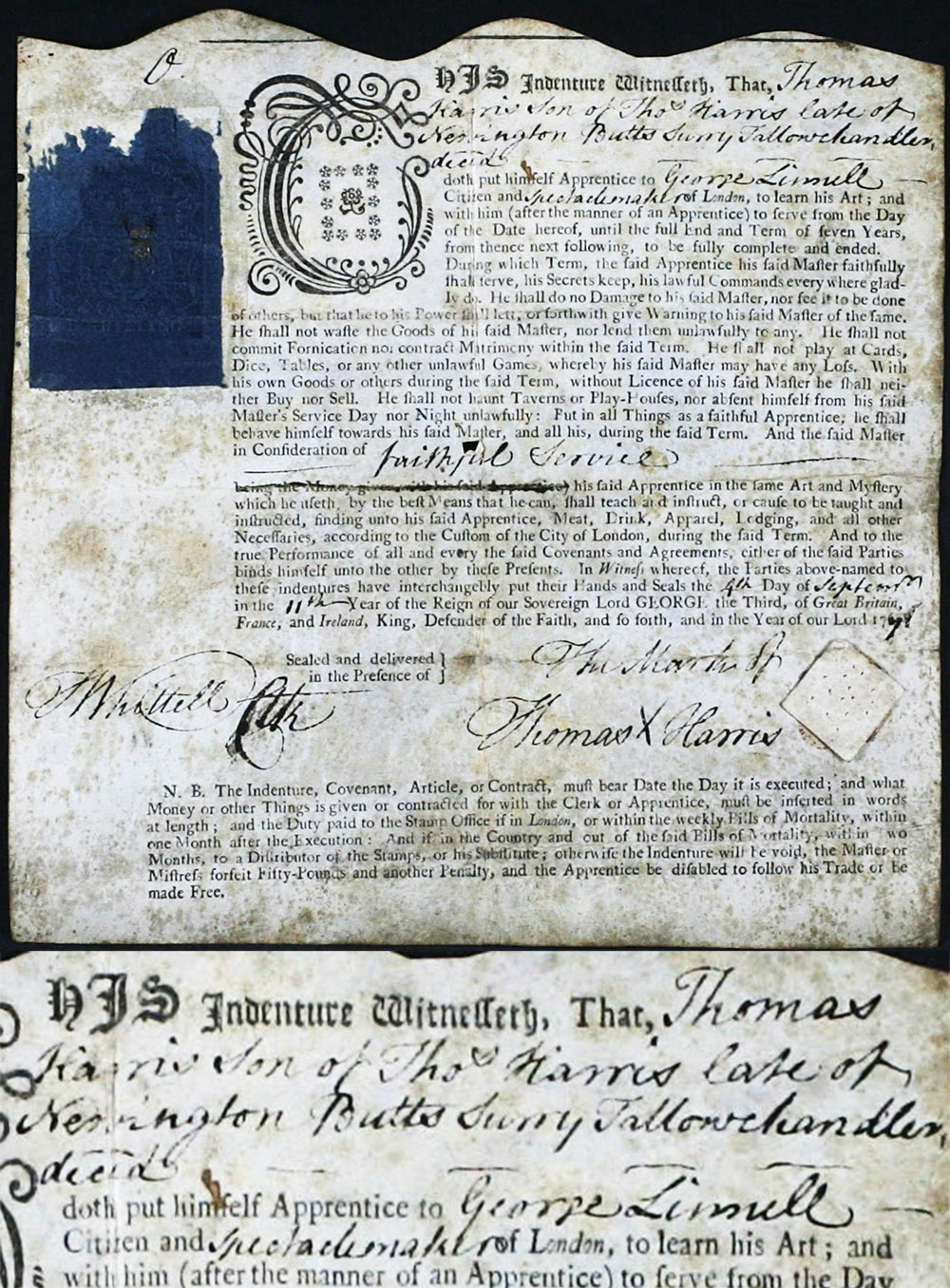
Figure 15.
Thomas Harris’ apprenticeship contract with “spectaclemaker” George Linnell. It is dated September 4, 1771, the “11th year of the reign of … George the Third” (who became King on October 5, 1760). At this time, Thomas was illiterate, and signed the contract with an “X”. Thomas’ father was also named Thomas, had died at this time (note “late” and “deced”), and had been a tallow chandler in Newington Butts, Surrey.
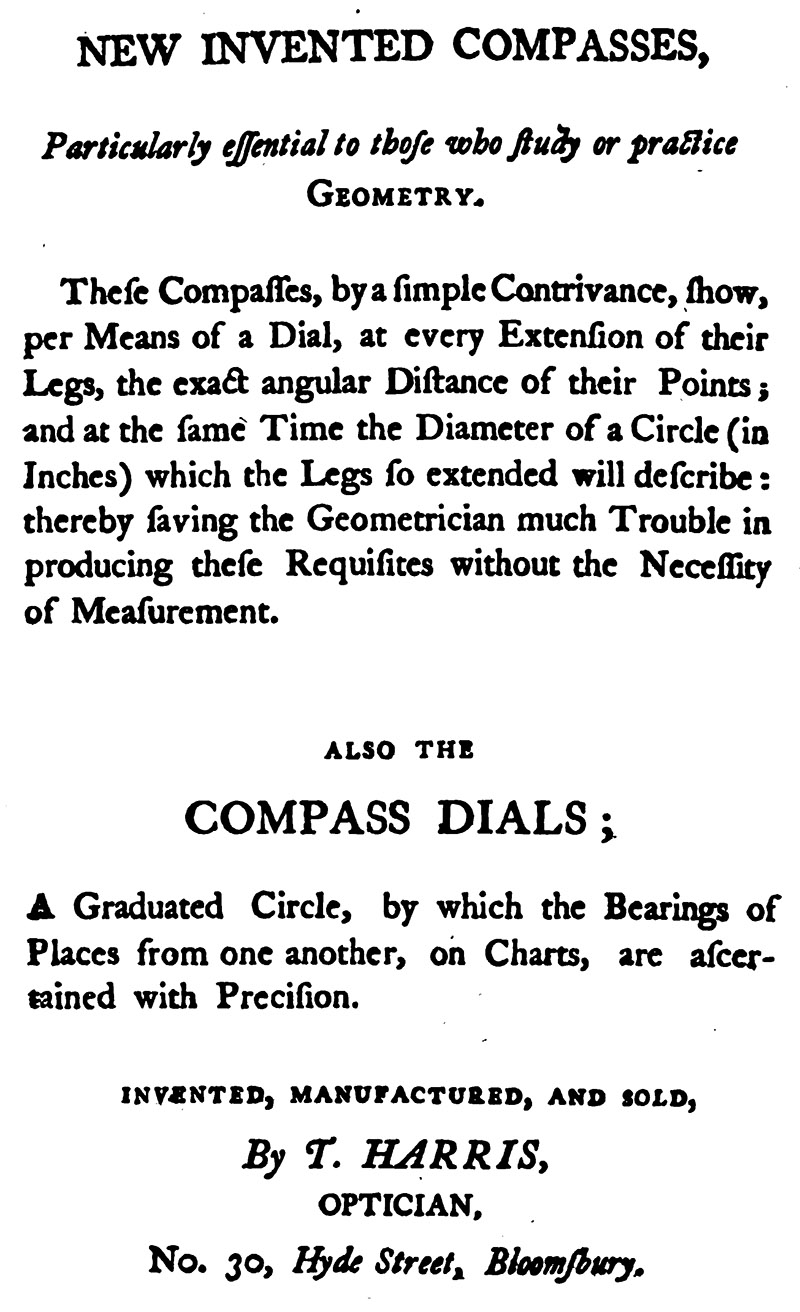
Figure 16.
A 1797 advertisement from Thomas Harris, from F.B. Watson’s “Companion to The Planispherical Planetarium”
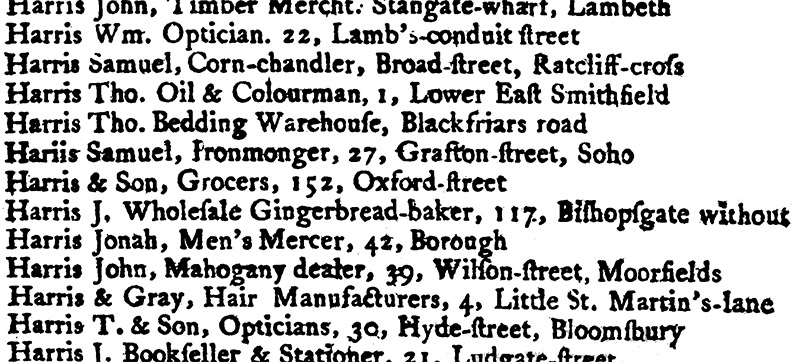
Figure 17.
An excerpt from the 1803 “Kent’s Directory of London”, showing the first known listing of T. Harris & Son. A few lines above is the entry for an unrelated man named William Harris, also an optician - his 1803 address of 22 Lamb’s Conduit was mistakenly listed by Gloria Clifton as an 1839-1841 address for Thomas Harris’ son, William. The William Harris who is listed in this directory moved to High Holborn shortly afterward.
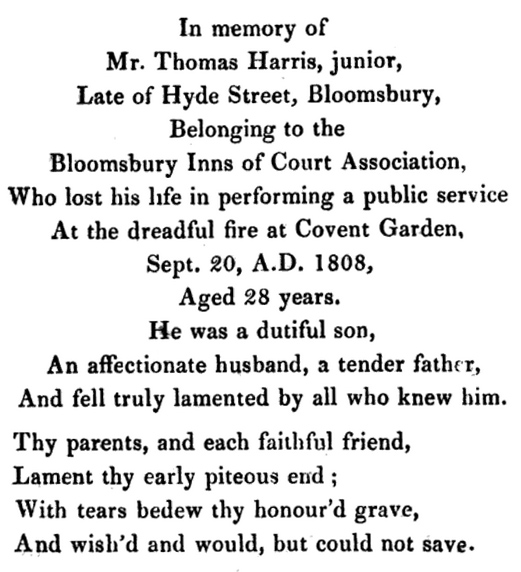
Figure 18.
Text of a memorial inscription for Thomas Harris, Jr. From Robert Orchard’s 1827 “A New Select Collection of Epitaphs and Remarkable Monumental Inscriptions”.

Figure 19.
A pair of globes by T. Harris & Son, 52 Great Russell Street. Son William was skilled in their construction, and was appointed globe-maker to the king and queen. Adapted for nonprofit, educational purposes from an auction site.
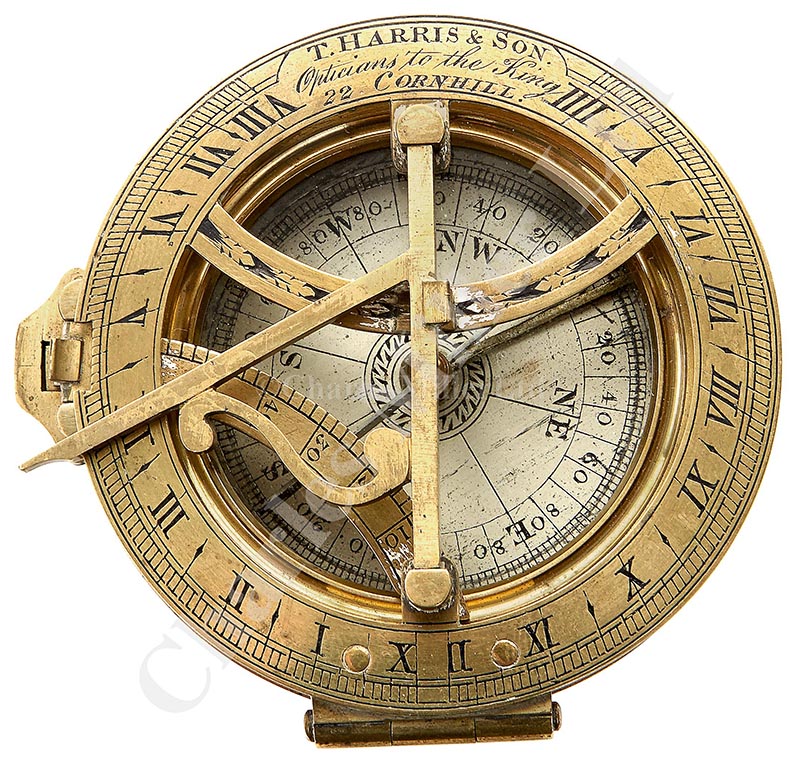
Figure 20.
A portable sundial from T. Harris & Son, 22 Cornhill. The name and address indicates production between 1827 and 1828, when Thomas and William were partners. Adapted for nonprofit, educational purposes from an auction site.
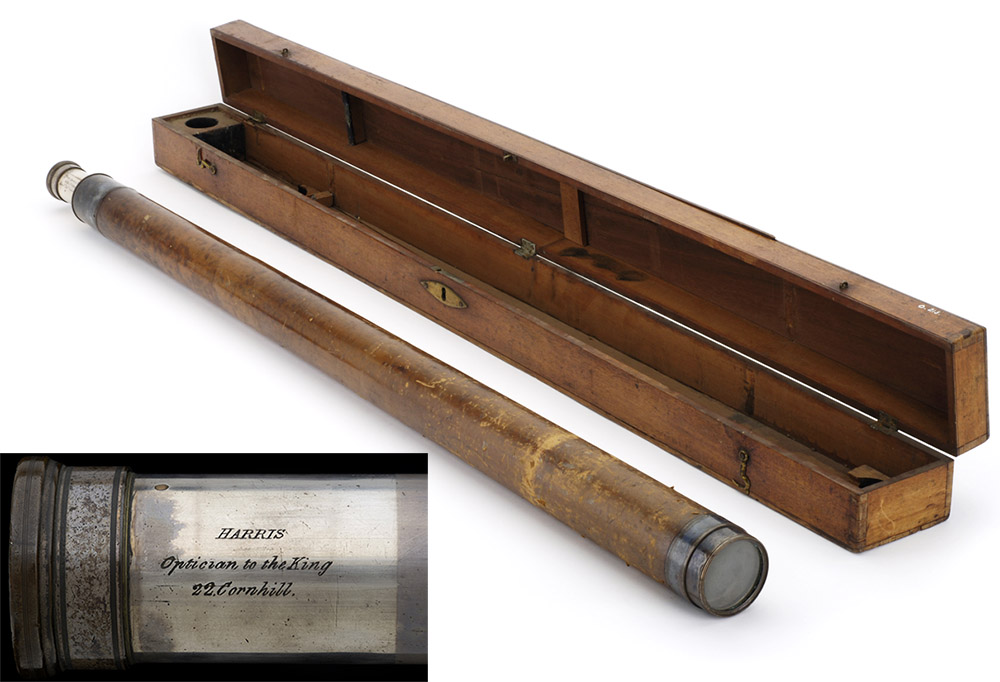
Figure 21.
A telescope that is marked “Harris, 22 Cornhill, London”. The signature indicates production between 1828, when the partnership was dissolved, and 1835, when William Harris moved to King William Street. Adapted for nonprofit, educational purposes from an auction site.
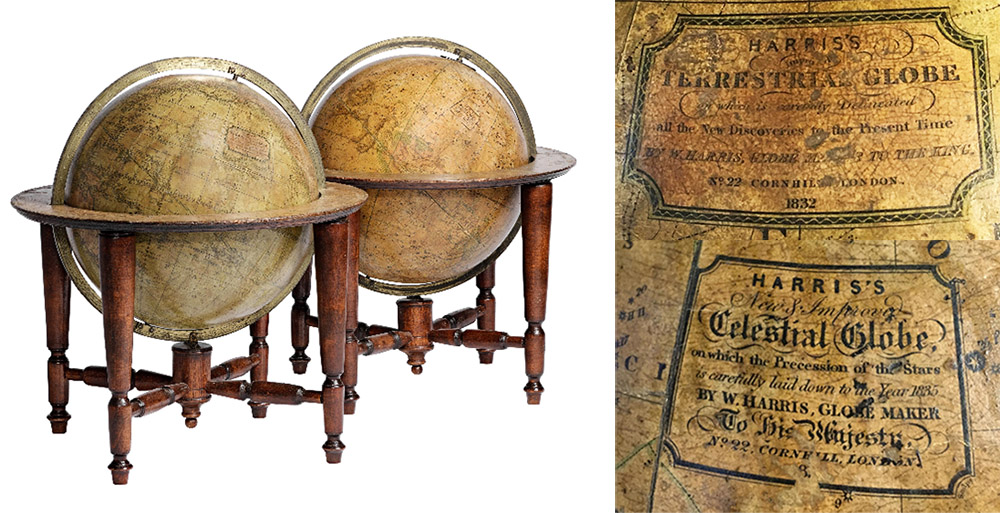
Figure 22.
A pair of globes from William Harris. Both give his address as 22 Cornhill, and are dated 1832 and 1835. Adapted for nonprofit, educational purposes from an auction site.
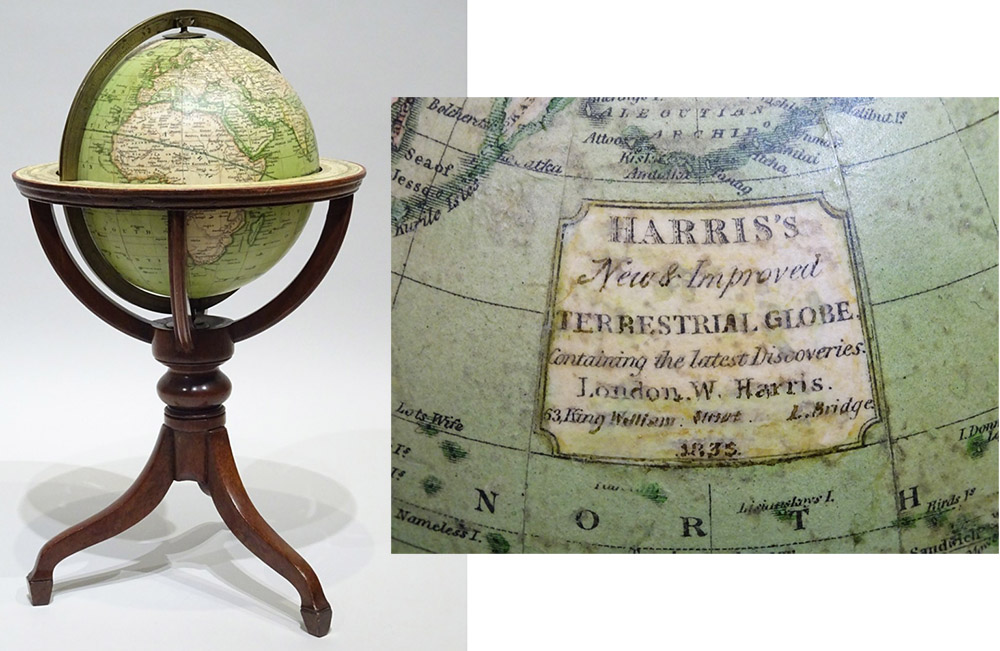
Figure 23.
A globe by William Harris, dated 1835 and giving his address as King William Street. This, and the instruments shown in Figure 22, indicate that he moved from 22 Cornhill during 1835. Adapted for nonprofit, educational purposes from an auction site.
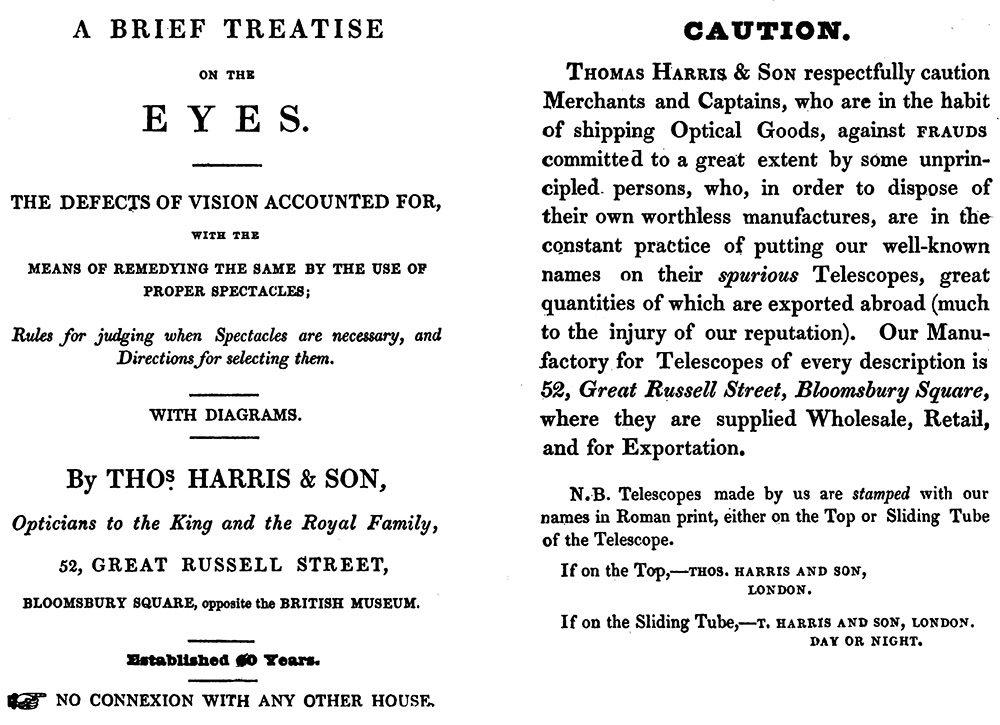
Figure 24.
Front page and an advertisement from Thomas P. Harris’ 1837 booklet on eyeglasses. By this time, eyeglasses and telescopes had become the major products of T. Harris & Son.
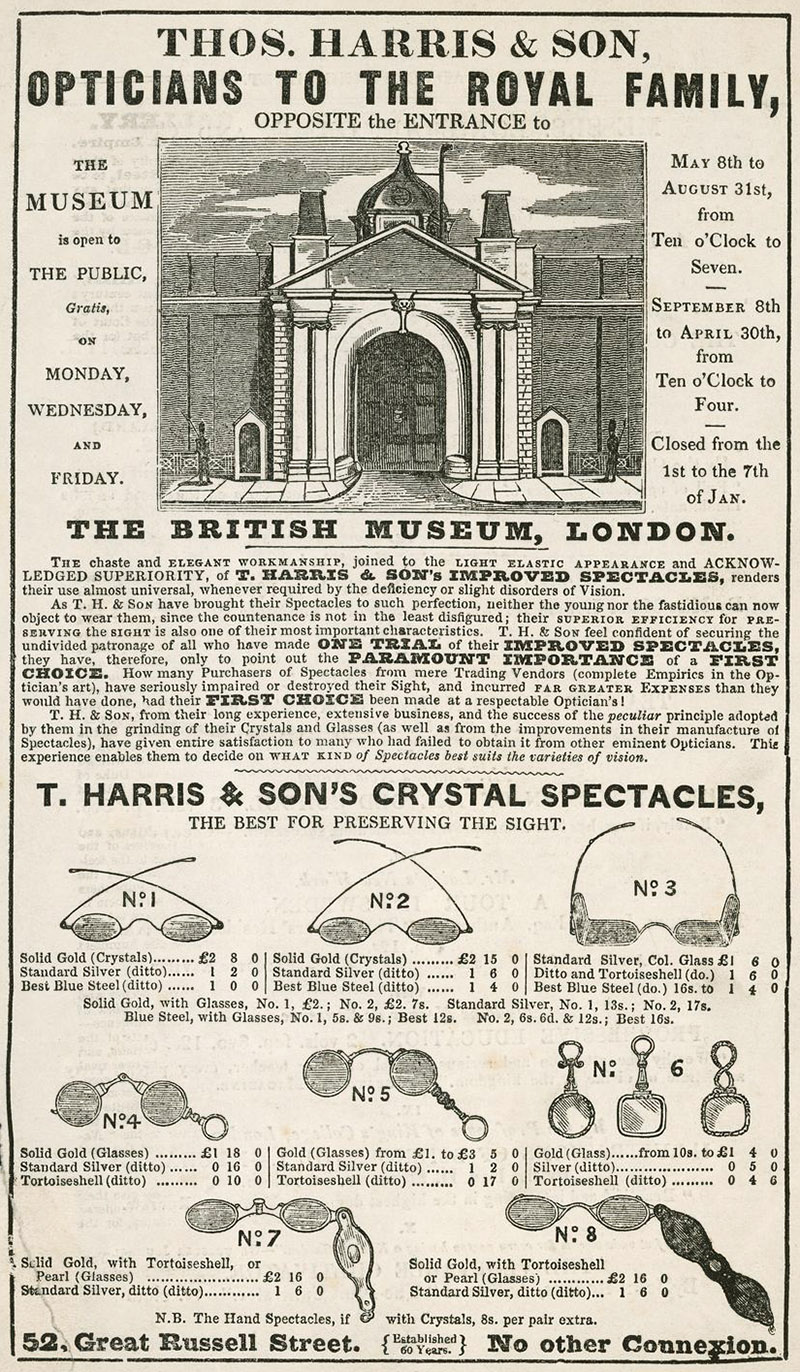
Figure 25.
An 1839 advertisement from “The Mirror”. The T. Harris & Son shop was located across the road from the British Museum, a landmark that was often cited in advertisements and products (see Figure 26). Adapted for nonprofit, educational purposes from https://collection.sciencemuseumgroup.org.uk/objects/co8002743/trade-card-thos-harris-son-trade-card.
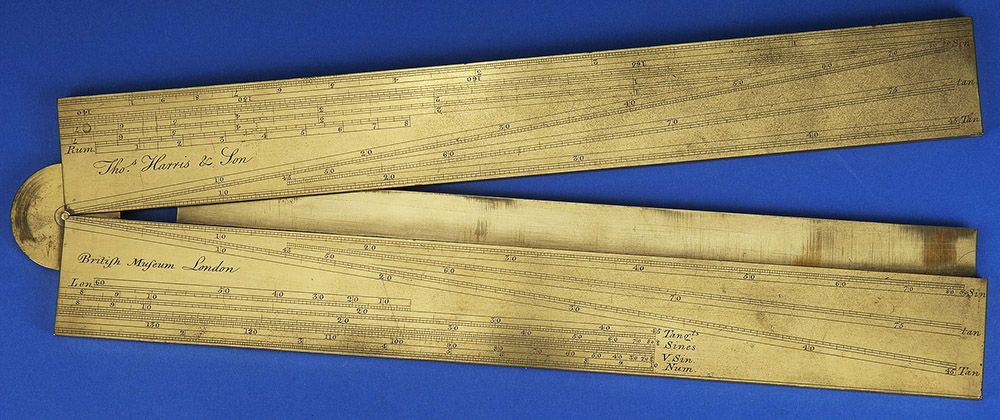
Figure 26.
A brass sector from T. Harris & Son, with address of simply “British Museum, London”. Adapted for nonprofit, educational purposes from https://americanhistory.si.edu/collections/search/object/nmah_1214780.
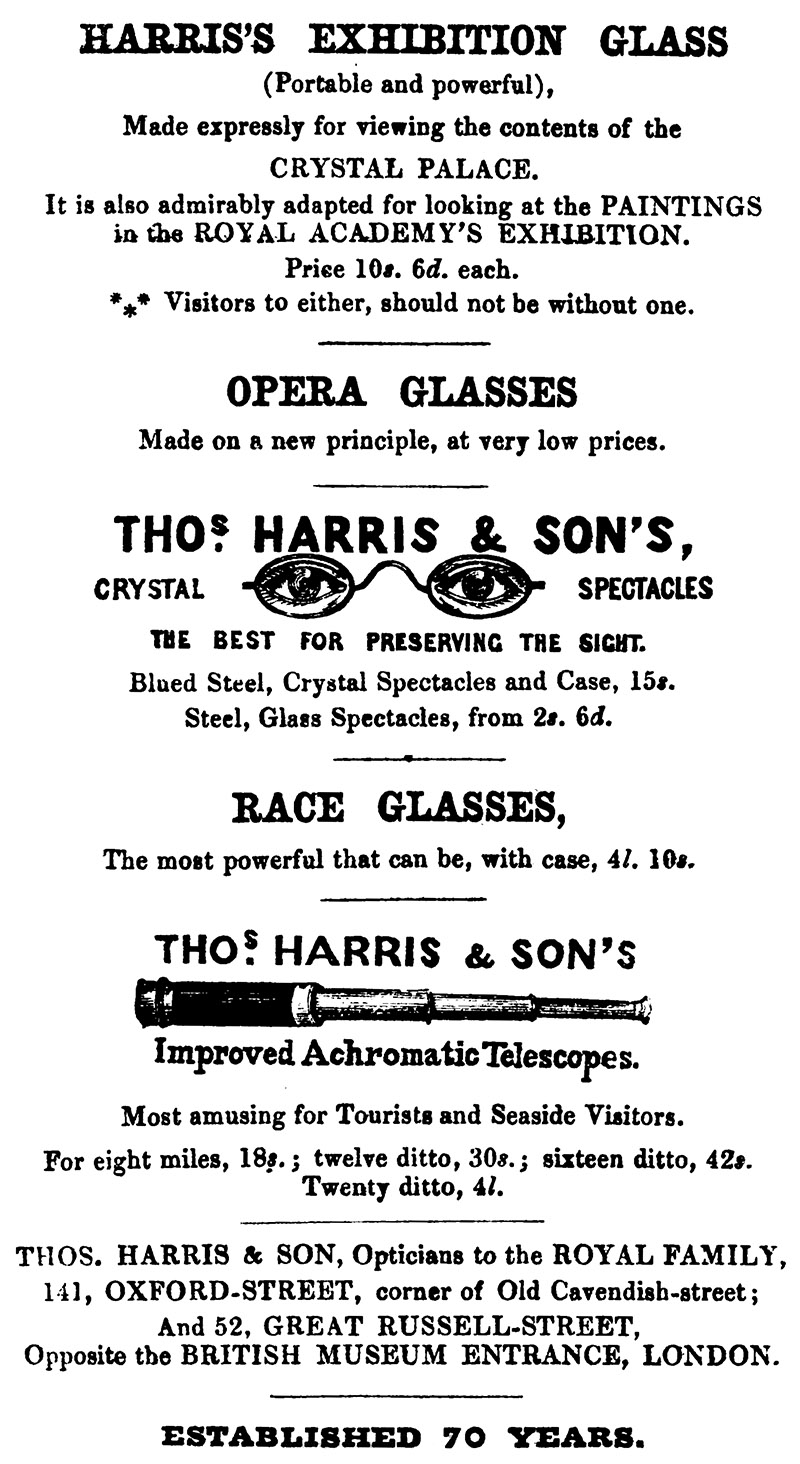
Figure 27.
An advertisement that was published during the 1851 London International Exposition. During that time, T. Harris & Son briefly had a branch shop at 141 Oxford Street.
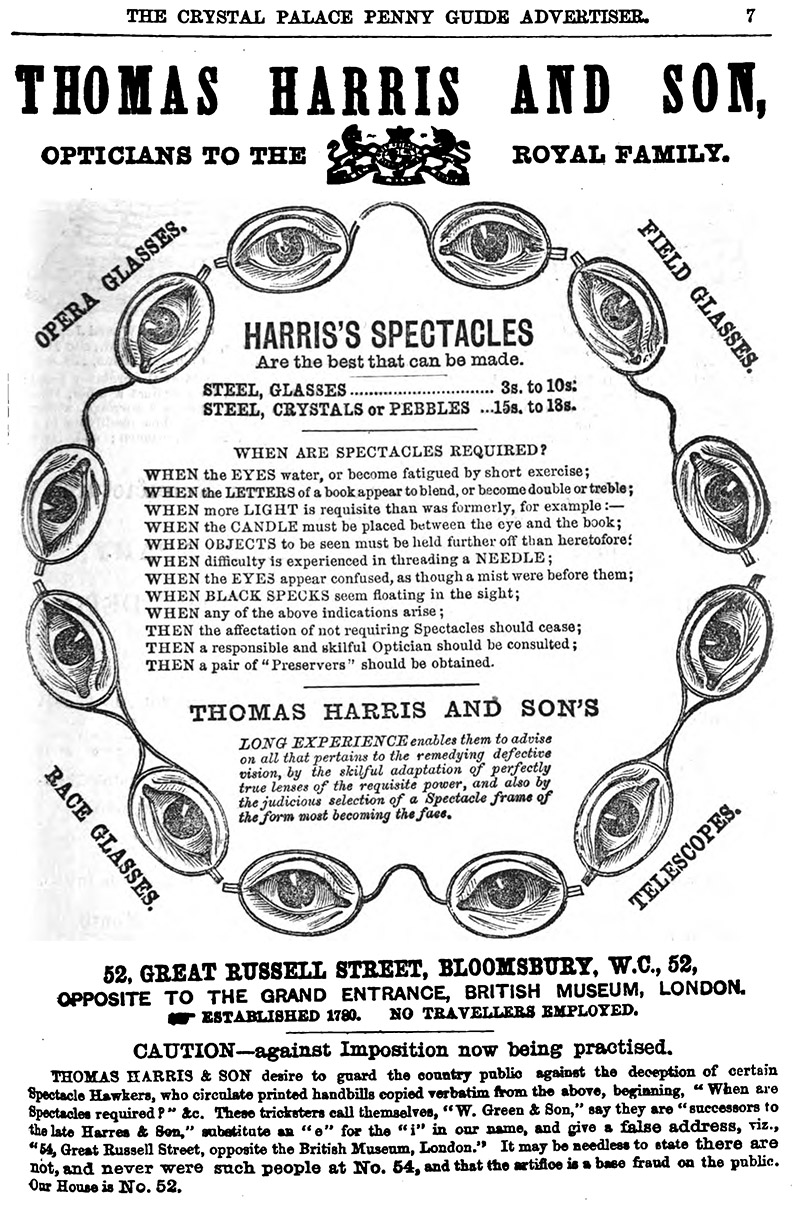
Figure 28.
An 1864 advertisement.

Figure 29.
An 1880 advertisement. It states that the business was founded in 1780.

Figure 30.
Entry from the 1900 “Post Office London Directory”.
Acknowledgements
Thank you to Joe Zeligs, Jeffrey Silverman, Helen Rayner, Maurizio Pizzigoni, Jurriaan de Groot, and Barry Sobel for sharing images and for helpful discussions.
Resources
Apprenticeship contract of Thomas Harris (1771) accessed through ancestry.com
Baptism record of Thomas Phillips Harris (1806) accessed through ancestry.com
J.A. Berly's British, American and Continental Electrical Directory and Advertiser (1883) “Harris, Thomas & Son, opticians, 52, Great Russell-street, London, W.C. … Harris, Henry, optician, 32, Gracechurch-street, London, E.C.”, page 212
Chemist and Druggist (1887) “The business of Messrs. Thomas Harris & Son, opticians and spectacle-makers, has been removed from opposite the British Museum to 32, Gracechurch Street, where it will be carried on in conjunction with the present business of Mr. Henry Harris, optician, and successor to the old firm”, Vol. 30, page 451
The Clergyman's Magazine (1880) Advertisement from T. Harris & Son, Vol. 11
Clifton, Gloria (1995) Directory of British Scientific Instrument Maker, 1550-1850, Zwemmer, London, pages 125-126
The Crystal Palace Penny Guide (1864) Advertisement from T. Harris & Son
Divorce records of Thomas Phillips and Annie Harris (1860) http://discovery.nationalarchives.gov.uk/details/r/C7971708
England census and other records, accessed through ancestry.com
Gardening and Rural Affairs (1827) Advertisement from Thomas Winter, page 126
Harris, Thomas (1837) A Brief Treatise on the Eyes
Journal of the Royal Microscopical Society (1884) Schieck's Revolver School and Drawing-room microscope Winter's and Harris's revolver microscopes, Series 2, Vol. 4, pages 112-115
Journal of the Royal Microscopical Society (1884) Winter's, Harris's, or Rubergall's revolver microscopes, Series 2, Vol. 4, page 284
Journal of the Royal Microscopical Society (1884) Harris & Son's portable microscopes, Series 2, Vol. 4, pages 611-612
Kent's Directory of London (1803) “Harris T. & Son, Opticians, 30, Hyde-street, Bloomsbury”, page 92
The London Gazette (1828) Notice of the dissolution of partnership between Thomas and William Harris
The London Gazette (1840) Arrest of William Harris, page 667
The London Gazette (1840) Bankruptcy of William Harris, page 3070
McConnell, Anita (1994) Bankruptcy proceedings against William Harris, Optician, of 22 Cornhill, Annals of Science, Vol. 51, pages 273-279
The Mirror (1839) Advertisement from T. Harris & Son, https://collection.sciencemuseumgroup.org.uk/objects/co8002743/trade-card-thos-harris-son-trade-card
The Monthly Magazine (1808) Report of the fire at Covent Garden Theatre, Vol. 26, pages 231-232, page 1196
Orchard, Robert (1827) A New Select Collection of Epitaphs and Remarkable Monumental Inscriptions, 2nd edition, James Taylor & Son, London, page 89
Phillips, Samuel (1854) Guide to the Crystal Palace and Park, Advertisement from T. Harris & Son
The Post Office London Directory (1807) “Harris T. & Son, Mathemat.-instrum.-mak. 30, Hyde-st, Bloomsb.”, page 122
The Post Office London Directory (1808) “Harris T. & Son, Mathemat.-instrum.-mak. 20, Hyde-st, Bloomsb.”, page 131
The Post Office London Directory (1812) “Harris Thomas & Son, Opticians, 52 Gt. Russell-st., Bloomsbury”, page 140
The Post Office London Directory (1817) “Harris Thos. & Son, Opticians, 52 Gt. Russell str. Bloomsbury”, page 149
The Post Office London Directory (1820) “Harris Thos. & Son, Opticians, 52 Great Russell-str. Bloomsbu.”, page 159
The Post Office London Directory (1845) “Harris Thomas & Son, opticians, 52 Gt. Russell st. Bloomsbury”, page 758
The Post Office London Directory (1845) “Harris Wm. Dollond, optician, & globe maker, 38 Arundel st”, page 759
The Post Office London Directory (1847) “Harris Wm. Dollond, optician, & globe maker, 38 Arundel st”, page 771
The Post Office London Directory (1862) “Harris Thomas & Son, opticians, spectacle makers, & improved opera glass, race glass, & telescope manufacturers, 43 & 52 Great Russell st WC, opposite the British Museum”, page 981
The Post Office London Directory (1900) page 1194
Pry, Paul (1839) Fashionable lounges, The Theatrical Observer, January 1 issue, page 2
Probate of the will of Thomas P. Harris (1892) “Harris Thomas Phillips of 40 Doughty Street Mecklenberg Square Middlesex gentleman died 26 January 1892 Probate London 22 February to Henry Harris optician and Charles Harris farmer Effects £5832 19s 3d”, accessed through ancestry.com
Richardson, John (1851) The Exhibition London Guide and Visitors' Pocket Companion, Etc., advertisement from T. Harris & Son, page vi
Robson’s London Street Directory (1832) “Great Russell Street … 52 Harris Thomas & Son” and “Cornhill … 22 Harris William”
The Royal Kalendar (1825) “Globe-Maker, T. and W. Harris”, page 119
The Royal Kalendar (1838) “Globe-Maker, T. and W. Harris”, page 121
The Shopkeeper's Guide (1853) “Steel Pen Manufacturers … Ross, Harris, and Co., 7, Earl-street, Blackfriars”, page 245 (the business of William Dollond Harris)
Wakefield's Merchant and Tradesman's General Directory for London (1794) no listing for Thomas Harris, optician
Watson, F.B. (1797) Companion to The Planispherical Planetarium, advertisement from Thomas Harris
Will of Thomas Harris (1831) accessed through ancestry.com
































